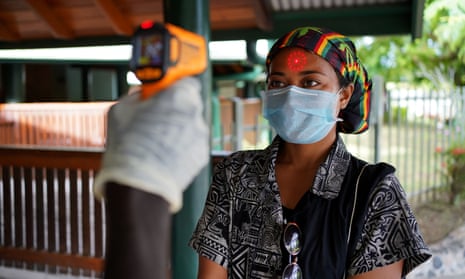Australia will increase its aid budget to only the Pacific and Timor-Leste this year as aid and development spending to all other parts of the world face further declines after years of swingeing cuts.
Although Australia’s aid budget has fractionally increased this year, the government has – unusually – reported it as a decline, instead allocating additional money as an extraordinary one-off supplement.
The 2020 budget’s headline figure for official development assistance has fallen again, from $4.044bn to $4bn.
But this year’s allocation has been boosted by an additional $304m over two years – $211m this year – to help the Pacific region respond to Covid. The foreign affairs minister, Marise Payne, said the additional funds would be targeted towards addressing the economic and social costs of the pandemic, “helping to underpin our region’s stability and economic recovery”.
But while the money is clearly aid, in the form of grants for development, it is being accounted for by the government in the budget as a “recovery fund” rather than as part of the official development assistance budget.
The director of the Development Policy Centre at the Australian National University, Prof Stephen Howes, said the unusual accounting of the aid increase seemed to have been made with domestic political considerations in mind, particularly during a time of recession and austerity.
“Clearly the government isn’t trying to earn a reputation for generosity. In fact, it seems like the opposite: it is trying to keep the increase in aid hidden. Presumably, the government wants to continue to be seen to be tough on aid – likely to ward off attacks from the likes of Pauline Hanson and others on the right.”
But Howes said the continuing rise in aid to the Pacific was the “driving force in the reshaping of Australia’s aid program”. Aid to the Pacific and Timor-Leste was about 23% of the aid budget in 2013-14. It has jumped to 43% this year.
Howes said the increase in aid to the Pacific represented a concession from the Australian government that its declared “Pacific step-up” could not be credible without extra money to the region.
But he said while an increase in Australia’s aid was welcome, prioritising the Pacific at the expense of other parts of the world was flawed: “It makes no sense to take $28m from a country like Afghanistan whose people are really suffering and give it to relatively stable and comparatively prosperous countries such as Samoa and Tonga.”
Australia’s aid spending – including the additional Covid spending – as a proportion of gross national income is 0.21%, the lowest it has ever been, and less than half the proportion it was in the 1970s. Five years ago official development assistance was more than $5bn.
Save for the Pacific and Timor-Leste, every region of the world has had its aid funding cut or flatlined. (While Timor-Leste is not in the Pacific, it is grouped with the region by the Australian government, as a near island neighbour facing similar development challenges.)
Budget analysis by Howes shows aid to west Asia has been cut by 27%, including a 35% cut to Afghanistan and a 66% cut to Pakistan. Aid programs to the Middle East and north Africa have been cut by 61%, and sub-Saharan Africa by 48%. South-east Asia is unchanged.
Australia has been the dominant aid partner in the Pacific for years, and remains far and away the most significant donor, but China’s spending commitments in the region are increasing rapidly, in the form of traditional grants but also concessional loans offered by Chinese state-owned enterprises, and which have to be paid back with interest.
Australia’s Pacific step-up is seen as a response to growing competition for regional influence with Beijing.
Tim Watkin, the head of government relations at the Australian Council for International Development, said the government’s willingness to find funds to fight Covid in the Pacific and Timor-Leste was a “welcome shot in the arm” for a region economically devastated by the decline in tourism, even if it has escaped the worst of the pandemic itself.
“Regional investment in vaccine access and health security is also very promising,” Watkin said. “But reductions in South and West Asia belies the Government’s intentions to be an Indo-Pacific partner of choice.”
The chief executive of Save the Children Australia, Paul Ronalds, said while additional money for Pacific and Timor-Leste was welcome, it was not sufficient. The pandemic would force more than 2.8 million people across the Pacific to survive on less than $2 a day – the definition of extreme poverty, Ronalds said.
“After years of devastating cuts, Australia’s foreign aid budget is simply not enough to meet the human needs in the region, nor serve Australia’s strategic interests at this time.”
